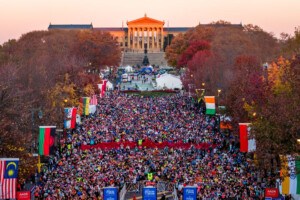The Broad Street Run Has Officially Gone Off the Rails
Last week, when Be Well Philly broke the news that the Blue Cross Broad Street Run would be switching to a lottery system for its 2013 registration, no one had anything nice to say.
Runners who’d been lining up at the North Philly start line for 20 years worried they’d be shut out. Some thought that this might be a good time to weed out the race-walkers with a qualifying time. Others were offended that a guaranteed spot would be offered to people who committed to raise $500 through a charity team, which, they said, amounted to shaking down friends and family for a bib number.
Interestingly, some were annoyed that next year’s Broad Street Run would offer so many spots—40,000 in 2013, roughly the same number of runners as the 2012 Broad Street Run. In fact, the jam-packed nature of last year’s race was the chief complaint about it afterwards: that there were too many runners tripping over each other, and that organizers should have capped it at 30,000 as planned. (For some perspective, the New York City Marathon fetches about 40,000 runners. So take the New York marathon, stuff it into our SEPTA system, and hurl it down our Main Street—this is the Broad Street Run as we now know it.)
No doubt about it: Broad Street touches a chord for many Philly runners. Until the past few years, when registration soared, the run itself—the actual one-foot-in-front-of-the-other down Broad Street—was almost irrelevant to everyone except the few thousand runners who actually did it. What mattered for everybody else—the spectators, the mayor—was that Philly turned into a hive of excitement on the first Sunday in May. It was one of the few days a year (save the equally beloved Mummers Parade) where we could open up our main artery and watch it pulsate. You wanted to schlep to Somerville Avenue at 8 a.m. in a Dunkin Donuts coffee-cup costume? That was your business. We’d drink to you anyway.
But the corporate-sponsored race of today looks very little like the small-time run that launched more than 30 years ago; as Broad Street’s popularity has grown, the question of what it should resemble more—a race or a parade—has gotten more complex. Runners who wake up early to do mile repeats have grown weary of elbowing their way past people in tutus to make it to the start line. Another contingency thinks these runners are a bunch of cranks, and that Broad Street is more a spirit-run than a competition.
But something truly snapped last year. It was my first (and now, probably, only) time running Broad Street. Sometime during the Internet-crashing registration cluster, or the squeeze into a claustrophobic subway car, or the 40-minute Port-A-Potty line, or the color-confused corral line-up, or the guy running past me dressed as some kind of woodland creature, it hit me: this race had gone off the rails. Broad Street had hit—exceeded, even—its point of critical mass.
That something must be done to rein in the registration process isn’t even a question. Race director Jim Marino pointed out to Be Well Philly that for people who couldn’t get to a computer during the first hour registration opened for 2012 (read: teachers, doctors, police officers, basically anyone not tethered to the Internet all day), there was no hope for entry. A lottery at least offers everyone a chance to register. And as a hat-tip to the legacy Broad Street has in Philly, race officials also say they’ll be offering some “race veterans”—no word yet on what that means—a chance to register early, before the unwashed masses.
On the one hand, Broad Street is one of Philly’s rare opportunities to show itself off. Because it’s in Philly’s DNA to be hopelessly attached to our traditions, sometimes to the point of insularity, no one likes the thought of excluding spirited Philadelphians from the race. And I get that.
But it also seems like this is a good occasion to come to terms with the fact that a successful race is a huge opportunity for cities; besides drawing out-of-towners and their tourism dollars, it’s a chance for a city to distinguish itself. The Philly Marathon may never have the clout that New York, Chicago, or Boston do, but Broad Street may have what it takes to become one of Philly’s elite races: a fast, downhill course, and a late spring date that makes for the perfect training season. Rather than a lottery, a qualifying time for Broad Street, one that simply guarantees entry rather than excluding anyone, may create the kind of race that Philly could really be proud of.
After all, the ragtag Philadelphia of the late 70s has grown up a lot in the last few decades. Maybe it’s time to let our hometown race do the same.
>> Tell us: What do you think is the best way to fix the Broad Street Run’s registration system, or any of the other issues the race faced last year? Share in the comments.


